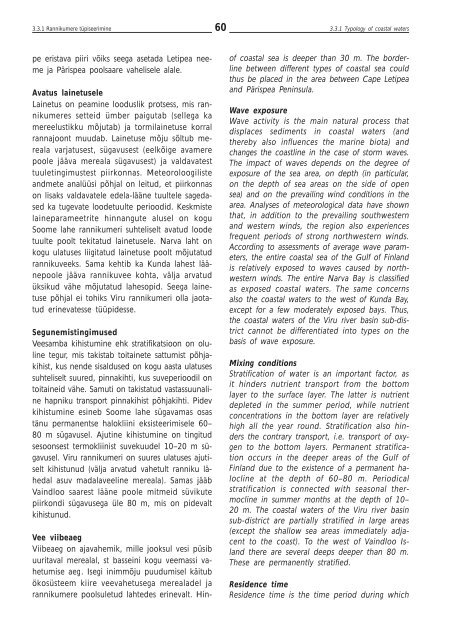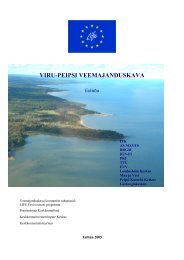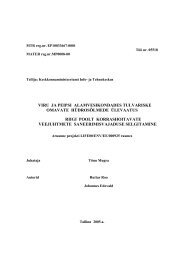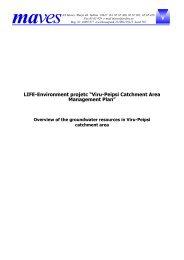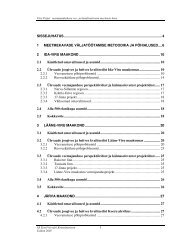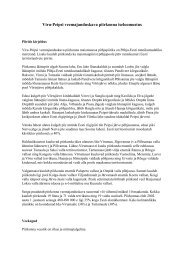Viru-Peipsi veemajanduskava - Keskkonnaministeerium
Viru-Peipsi veemajanduskava - Keskkonnaministeerium
Viru-Peipsi veemajanduskava - Keskkonnaministeerium
You also want an ePaper? Increase the reach of your titles
YUMPU automatically turns print PDFs into web optimized ePapers that Google loves.
3.3.1 Rannikumere tüpiseerimine<br />
60<br />
3.3.1 Typology of coastal waters<br />
pe eristava piiri võiks seega asetada Letipea neeme<br />
ja Pärispea poolsaare vahelisele alale.<br />
Avatus lainetusele<br />
Lainetus on peamine looduslik protsess, mis rannikumeres<br />
setteid ümber paigutab (sellega ka<br />
mereelustikku mõjutab) ja tormilainetuse korral<br />
rannajoont muudab. Lainetuse mõju sõltub mereala<br />
varjatusest, sügavusest (eelkõige avamere<br />
poole jääva mereala sügavusest) ja valdavatest<br />
tuuletingimustest piirkonnas. Meteoroloogiliste<br />
andmete analüüsi põhjal on leitud, et piirkonnas<br />
on lisaks valdavatele edela-lääne tuultele sagedased<br />
ka tugevate loodetuulte perioodid. Keskmiste<br />
laineparameetrite hinnangute alusel on kogu<br />
Soome lahe rannikumeri suhteliselt avatud loode<br />
tuulte poolt tekitatud lainetusele. Narva laht on<br />
kogu ulatuses liigitatud lainetuse poolt mõjutatud<br />
rannikuveeks. Sama kehtib ka Kunda lahest läänepoole<br />
jääva rannikuvee kohta, välja arvatud<br />
üksikud vähe mõjutatud lahesopid. Seega lainetuse<br />
põhjal ei tohiks <strong>Viru</strong> rannikumeri olla jaotatud<br />
erinevatesse tüüpidesse.<br />
Segunemistingimused<br />
Veesamba kihistumine ehk stratifikatsioon on oluline<br />
tegur, mis takistab toitainete sattumist põhjakihist,<br />
kus nende sisaldused on kogu aasta ulatuses<br />
suhteliselt suured, pinnakihti, kus suveperioodil on<br />
toitaineid vähe. Samuti on takistatud vastassuunaline<br />
hapniku transport pinnakihist põhjakihti. Pidev<br />
kihistumine esineb Soome lahe sügavamas osas<br />
tänu permanentse halokliini eksisteerimisele 60–<br />
80 m sügavusel. Ajutine kihistumine on tingitud<br />
sesoonsest termokliinist suvekuudel 10–20 m sügavusel.<br />
<strong>Viru</strong> rannikumeri on suures ulatuses ajutiselt<br />
kihistunud (välja arvatud vahetult ranniku lähedal<br />
asuv madalaveeline mereala). Samas jääb<br />
Vaindloo saarest lääne poole mitmeid süvikute<br />
piirkondi sügavusega üle 80 m, mis on pidevalt<br />
kihistunud.<br />
Vee viibeaeg<br />
Viibeaeg on ajavahemik, mille jooksul vesi püsib<br />
uuritaval merealal, st basseini kogu veemassi vahetumise<br />
aeg. Isegi inimmõju puudumisel käitub<br />
ökosüsteem kiire veevahetusega merealadel ja<br />
rannikumere poolsuletud lahtedes erinevalt. Hinof<br />
coastal sea is deeper than 30 m. The borderline<br />
between different types of coastal sea could<br />
thus be placed in the area between Cape Letipea<br />
and Pärispea Peninsula.<br />
Wave exposure<br />
Wave activity is the main natural process that<br />
displaces sediments in coastal waters (and<br />
thereby also influences the marine biota) and<br />
changes the coastline in the case of storm waves.<br />
The impact of waves depends on the degree of<br />
exposure of the sea area, on depth (in particular,<br />
on the depth of sea areas on the side of open<br />
sea) and on the prevailing wind conditions in the<br />
area. Analyses of meteorological data have shown<br />
that, in addition to the prevailing southwestern<br />
and western winds, the region also experiences<br />
frequent periods of strong northwestern winds.<br />
According to assessments of average wave parameters,<br />
the entire coastal sea of the Gulf of Finland<br />
is relatively exposed to waves caused by northwestern<br />
winds. The entire Narva Bay is classified<br />
as exposed coastal waters. The same concerns<br />
also the coastal waters to the west of Kunda Bay,<br />
except for a few moderately exposed bays. Thus,<br />
the coastal waters of the <strong>Viru</strong> river basin sub-district<br />
cannot be differentiated into types on the<br />
basis of wave exposure.<br />
Mixing conditions<br />
Stratification of water is an important factor, as<br />
it hinders nutrient transport from the bottom<br />
layer to the surface layer. The latter is nutrient<br />
depleted in the summer period, while nutrient<br />
concentrations in the bottom layer are relatively<br />
high all the year round. Stratification also hinders<br />
the contrary transport, i.e. transport of oxygen<br />
to the bottom layers. Permanent stratification<br />
occurs in the deeper areas of the Gulf of<br />
Finland due to the existence of a permanent halocline<br />
at the depth of 60–80 m. Periodical<br />
stratification is connected with seasonal thermocline<br />
in summer months at the depth of 10–<br />
20 m. The coastal waters of the <strong>Viru</strong> river basin<br />
sub-district are partially stratified in large areas<br />
(except the shallow sea areas immediately adjacent<br />
to the coast). To the west of Vaindloo Island<br />
there are several deeps deeper than 80 m.<br />
These are permanently stratified.<br />
Residence time<br />
Residence time is the time period during which


